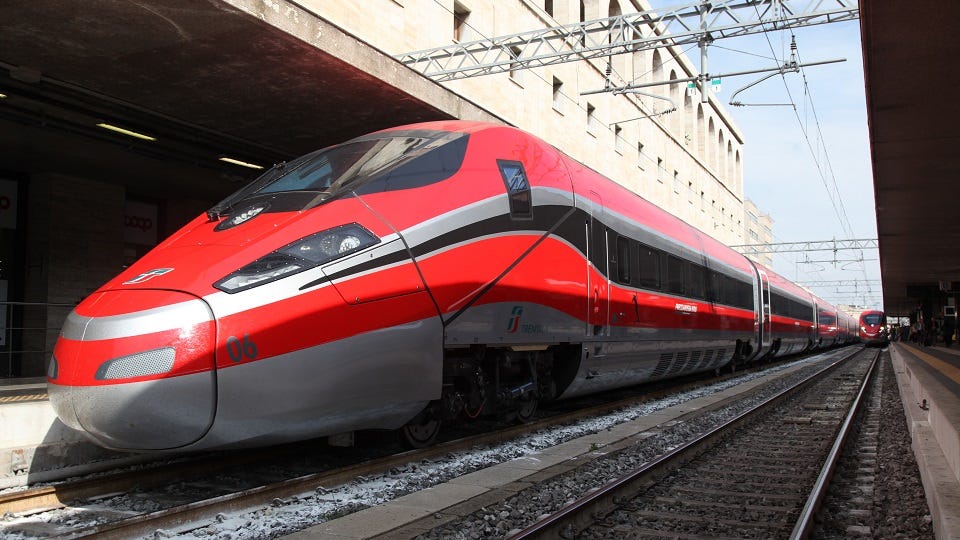Trenitalia’s French expansion exposes EU rail liberalisation paradox

Trenitalia’s growth in France highlights a central paradox of EU rail liberalisation: competition exists, but mainly between state-owned incumbents rather than private challengers. With seat occupancy above 70% on Paris–Marseille but losses projected until 2027, the case shows how state-backed operators shape the high-speed market.
Trenitalia France attracts strong demand, with more than 70% of seats filled on the Paris–Marseille route within three months of launch. Yet the company expects to remain loss-making until at least 2027, citing high track usage fees and limited rolling stock.
The operator plans to raise weekday Paris–Lyon services from nine to 14 round-trips this December, securing over one-third of frequencies on Europe’s busiest high-speed corridor. This growth continues despite cumulative losses exceeding EUR 150 million since 2021.
Trenitalia’s parent FS Group also absorbed losses of around EUR 8 million per month during the two-year Maurienne landslide closure, which cut the Paris–Milan line. Such sustained deficits would likely have forced a private operator to withdraw.
Private entrants face structural barriers
Spain’s Renfe illustrates the challenge. After announcing French services in 2023, it has delayed expansion due to safety approvals and shelved Paris connections. Other planned entrants – including Proxima, Kevin Speed and Le Train – remain at project stage with no launch date.
Lacking state balance sheets, these operators cannot cover prolonged losses while financing rolling stock, depots and access fees. Trenitalia benefits from FS Group’s EUR 14 billion annual revenue, while SNCF is backed by the French state. Deutsche Bahn remains a potential competitor but is focused on domestic restructuring.
Market timing and pricing strategy
Trenitalia is expanding at a moment of opportunity. SNCF’s new TGV-M fleet, originally due in 2024, will not arrive before 2026. This delay leaves space for Trenitalia’s Frecciarossa 1000 trains to capture market share.
Tickets on Paris–Lyon start at EUR 23, undercutting SNCF’s Inoui services. The strategy prioritises volume and scale over near-term profitability, with breakeven expected only once capacity stabilises.
Infrastructure charges remain the largest cost driver. High French track fees – around four times higher than in Italy – contribute to ongoing losses. Entry discounts have expired, creating barriers that make long-term participation difficult without state backing.
Policy framework under strain
The EU’s 4th Railway Package aimed to create open competition, particularly through private operators challenging incumbents. Instead, market opening has produced state-versus-state rivalry, with national champions expanding into each other’s territories.
This dynamic raises questions about state aid. Italian taxpayers indirectly subsidise Trenitalia’s challenge to SNCF, which in turn prepares its own entry into Italy from 2026. Current EU rules offer limited tools to address strategic loss-making by groups that remain profitable overall.
The assumption that incumbents would behave like private companies has proven incomplete. State operators pursue long-term strategies supported by public resources, while private entrants face structural barriers.
Consolidation around national champions
The market increasingly consolidates around a few state-owned players. Trenitalia and SNCF dominate the French–Italian axis, while Czech operator ČD has strengthened in Slovakia. By contrast, several announced private projects have stalled.
This reduces diversity in the liberalised market. While passengers benefit from lower fares and more choice on certain routes, the underlying dynamic entrenches the dominance of well-capitalised incumbents competing beyond their home markets.
Conclusion: competition without privatisation
Trenitalia’s expansion in France demonstrates the paradox of EU rail liberalisation: open access has created competition, but largely between national operators. Financial capacity, infrastructure charges and rolling stock availability favour state-backed groups able to sustain long-term losses.
With Trenitalia targeting profitability in 2027 and SNCF preparing Italian entry from 2026, cross-border competition is set to intensify. The open question for Brussels is whether this outcome represents success – more international services at lower fares – or failure, given the absence of the private challengers originally envisaged.
Key figures
Financial impact
Maurienne closure losses: EUR 8 million/month
Breakeven target: 2027
FS Group annual revenue: EUR 14 billion
Service expansion
Paris–Lyon: 9 → 14 daily services (+55%)
Market share on Paris–Lyon: >33%
Paris–Marseille seat occupancy: >70%
Paris–Lyon tickets: from EUR 23

